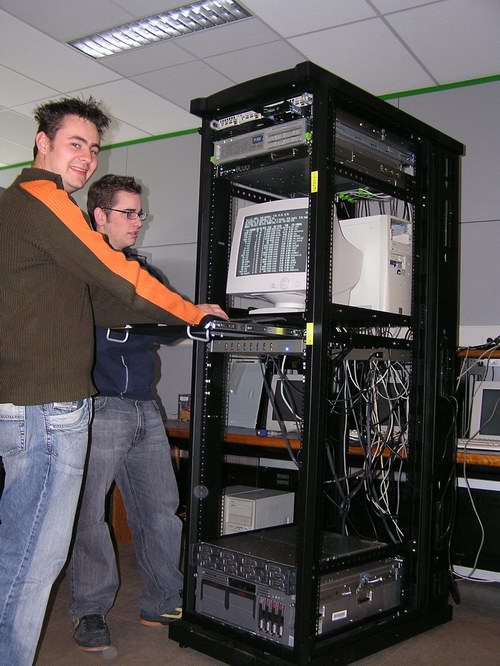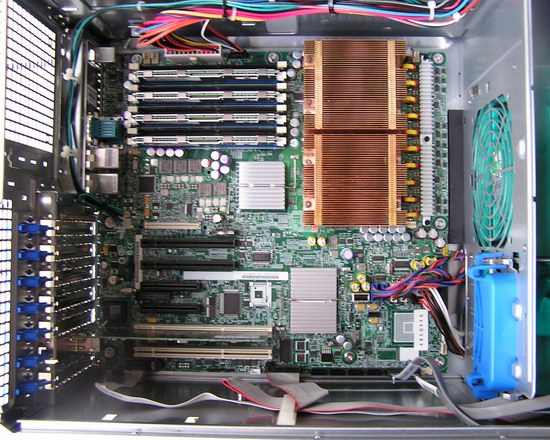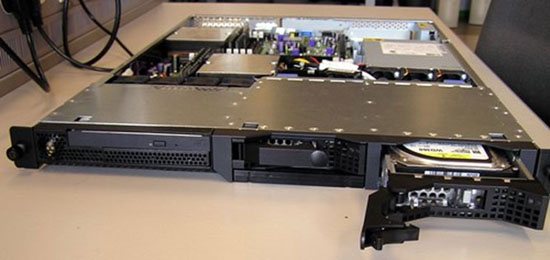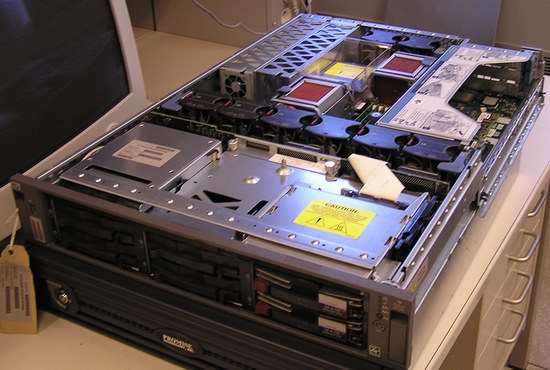Intel Woodcrest, AMD's Opteron and Sun's UltraSparc T1: Server CPU Shoot-out
by Johan De Gelas on June 7, 2006 12:00 PM EST- Posted in
- IT Computing
Words of Thanks
A lot of people gave us assistance with this project, and we like to thank them of course.
Waseem Ahmad, Intel US
Matty Bakkeren, Intel Netherlands
Trevor E. Lawless, Intel US
(www.intel.com)
Chhandomay Mandal, Sun US
Luojia Chen, Sun US
Peter A. Wilson, Sun US
(www.sun.com)
Peter Zaitsev, Elite MySQL Guru
(www.mysql.com)
Damon Muzny, AMD US
(www.amd.com)
Steve Olson, Sybase US
(www.sybase.com)
Erwin Vanluchene, HP Belgium
(www.hp.be)
Ilona van Poppel, MSI Netherlands
Ruudt Swanen, MSI Netherlands
(www.msi-computer.nl)
Alexander Goodrich, Assembler Guru
Bert Devriese, Developer of MySQL & PHP benchmark
Dieter Saeys, Gentoo/Linux support
Brecht Kets, Development of Improved Bench program
Tijl Deneut, Solaris, PostGreSQL and MySQL support
I also like to thank Lode De Geyter, manager of the University College of West-Flanders. Further information about our server research is available on our website.
Benchmark Configuration
We used Solaris 10 for the Sun T2000, as the only supported OS for the T2000 right now is Solaris 10 3/05 HW2 (and upwards). The T1 is fully binary compatibility with the existing SPARC binaries but needs this version of Solaris.
Below is a picture of our Server lab at the University College of West-Flanders. You can see Bert and Dieter standing next to our brand new rack of the server research lab.

From top to bottom, we have the Supermicro SuperServer 6014P-32, the MSI K2-102A2M, the Sun T2000, our own PIII based Linux gateway and firewall, and at the bottom, the Promise JBOD300s and the HP DL585. Yes, we still have a lot of benchmarking to do. The other Intel based machines are in towers, so you won't find them in our rack.
All benchmarking is monitored: CPU load, network and disk I/O are watched using CPU graph, top, vmstat and prstat. This way we can determine whether or not the CPU or another component is the bottleneck.
Our web server tests are performed on Apache2 2.0.55, including the mod_deflate module for gzip compression, PHP4.4.1 and Mysql 5.0.21.
Hardware Configurations
Here is the list of the different server configurations:
Sun T2000:
Sun UltraSparc T1 1 GHz, 8 cores, 32 threads
Sun Solaris 10
32 GB (16x2048 MB) Crucial DDR-2 533
NIC: 1 Gb Intel RC82540EM - Intel E1000 driver.
You can find much more information about the T1 CPU in our previous article.
Intel Server 1:
Dual Intel Xeon "Woodcrest" 3 GHz Shared 4 MB L2 cache, 1333 MHz FSB (4 cores total)

Blackford Chipset
64 bit Gentoo Kernel 2.6.15-gentoo-r7
Intel Server Board S5000
4 GB (4x1024 MB) Micron FB-DIMM Registered DDR2-533 CAS 4, ECC enabled
NIC: Dual Intel PRO/1000 Server NIC
2x Western Digital Raptor 36 GB SATA
Intel Server 2:
Dual Intel Xeon "Irwindale" 3.6 GHz 2 MB L2 cache, 800 MHz FSB - Lindenhurst
64 bit Gentoo Kernel 2.6.15-gentoo-r7
Intel Server Board SE7520AF2
8 GB (8x1024 MB) Micron Registered DDR2-400 CAS 3, ECC enabled
NIC: Dual Intel PRO/1000 Server NIC (Intel 82546GB controller)
2x Western Digital Raptor 36 GB SATA
Opteron Server 1: Dual Opteron 275 2.2 GHz 2x1MB L2 cache (4 cores total)
64 bit Gentoo Kernel 2.6.15-gentoo-r7
Solaris x86 10
MSI K8N Master2-FAR
4 GB: 4x1GB MB Crucial DDR-400 (3-3-3-6)
NIC: Broadcom BCM5721 (PCI-E)
2x Western Digital Raptor 36 GB SATA
Opteron Server 2: MSI K2-102A2M

ServerWorksHT2000 Chipset
64 bit Gentoo Kernel 2.6.15-gentoo-r7
4 GB: 4x1GB MB Crucial DDR-400 (3-3-3-6)
NIC: Broadcom BCM5721 (PCI-E)
2x Western Digital Raptor 36 GB SATA
Opteron Server 3: HP DL385

Solaris x86 10
AMD 81xx chipset
64 bit Gentoo Kernel 2.6.15-gentoo-r7
4 GB: 4x1GB MB Crucial DDR-400 (3-3-3-6)
NIC: Broadcom BCM5721 (PCI-E)
2x Seagate Cheetah 36 GB - 15000 rpm - SCSI 320 MB/s
Client Configuration: Dual Opteron 850
MSI K8T Master1-FAR
4x512 MB Infineon Registered DDR-333, ECC
NIC: Broadcom 5705
Common Software
64 bit Gentoo Kernel 2.6.15-gentoo-r7
Apache2 2.0.55 + mod_deflate module for gzip compression.
PHP4.4.1
Mysql5.0.21
A lot of people gave us assistance with this project, and we like to thank them of course.
Waseem Ahmad, Intel US
Matty Bakkeren, Intel Netherlands
Trevor E. Lawless, Intel US
(www.intel.com)
Chhandomay Mandal, Sun US
Luojia Chen, Sun US
Peter A. Wilson, Sun US
(www.sun.com)
Peter Zaitsev, Elite MySQL Guru
(www.mysql.com)
Damon Muzny, AMD US
(www.amd.com)
Steve Olson, Sybase US
(www.sybase.com)
Erwin Vanluchene, HP Belgium
(www.hp.be)
Ilona van Poppel, MSI Netherlands
Ruudt Swanen, MSI Netherlands
(www.msi-computer.nl)
Alexander Goodrich, Assembler Guru
Bert Devriese, Developer of MySQL & PHP benchmark
Dieter Saeys, Gentoo/Linux support
Brecht Kets, Development of Improved Bench program
Tijl Deneut, Solaris, PostGreSQL and MySQL support
I also like to thank Lode De Geyter, manager of the University College of West-Flanders. Further information about our server research is available on our website.
Benchmark Configuration
We used Solaris 10 for the Sun T2000, as the only supported OS for the T2000 right now is Solaris 10 3/05 HW2 (and upwards). The T1 is fully binary compatibility with the existing SPARC binaries but needs this version of Solaris.
Below is a picture of our Server lab at the University College of West-Flanders. You can see Bert and Dieter standing next to our brand new rack of the server research lab.

From top to bottom, we have the Supermicro SuperServer 6014P-32, the MSI K2-102A2M, the Sun T2000, our own PIII based Linux gateway and firewall, and at the bottom, the Promise JBOD300s and the HP DL585. Yes, we still have a lot of benchmarking to do. The other Intel based machines are in towers, so you won't find them in our rack.
All benchmarking is monitored: CPU load, network and disk I/O are watched using CPU graph, top, vmstat and prstat. This way we can determine whether or not the CPU or another component is the bottleneck.
Our web server tests are performed on Apache2 2.0.55, including the mod_deflate module for gzip compression, PHP4.4.1 and Mysql 5.0.21.
Hardware Configurations
Here is the list of the different server configurations:
Sun T2000:
Sun UltraSparc T1 1 GHz, 8 cores, 32 threads
Sun Solaris 10
32 GB (16x2048 MB) Crucial DDR-2 533
NIC: 1 Gb Intel RC82540EM - Intel E1000 driver.
You can find much more information about the T1 CPU in our previous article.
Intel Server 1:
Dual Intel Xeon "Woodcrest" 3 GHz Shared 4 MB L2 cache, 1333 MHz FSB (4 cores total)

Blackford Chipset
64 bit Gentoo Kernel 2.6.15-gentoo-r7
Intel Server Board S5000
4 GB (4x1024 MB) Micron FB-DIMM Registered DDR2-533 CAS 4, ECC enabled
NIC: Dual Intel PRO/1000 Server NIC
2x Western Digital Raptor 36 GB SATA
Intel Server 2:
Dual Intel Xeon "Irwindale" 3.6 GHz 2 MB L2 cache, 800 MHz FSB - Lindenhurst
64 bit Gentoo Kernel 2.6.15-gentoo-r7
Intel Server Board SE7520AF2
8 GB (8x1024 MB) Micron Registered DDR2-400 CAS 3, ECC enabled
NIC: Dual Intel PRO/1000 Server NIC (Intel 82546GB controller)
2x Western Digital Raptor 36 GB SATA
Opteron Server 1: Dual Opteron 275 2.2 GHz 2x1MB L2 cache (4 cores total)
64 bit Gentoo Kernel 2.6.15-gentoo-r7
Solaris x86 10
MSI K8N Master2-FAR
4 GB: 4x1GB MB Crucial DDR-400 (3-3-3-6)
NIC: Broadcom BCM5721 (PCI-E)
2x Western Digital Raptor 36 GB SATA
Opteron Server 2: MSI K2-102A2M

ServerWorksHT2000 Chipset
64 bit Gentoo Kernel 2.6.15-gentoo-r7
4 GB: 4x1GB MB Crucial DDR-400 (3-3-3-6)
NIC: Broadcom BCM5721 (PCI-E)
2x Western Digital Raptor 36 GB SATA
Opteron Server 3: HP DL385

Solaris x86 10
AMD 81xx chipset
64 bit Gentoo Kernel 2.6.15-gentoo-r7
4 GB: 4x1GB MB Crucial DDR-400 (3-3-3-6)
NIC: Broadcom BCM5721 (PCI-E)
2x Seagate Cheetah 36 GB - 15000 rpm - SCSI 320 MB/s
Client Configuration: Dual Opteron 850
MSI K8T Master1-FAR
4x512 MB Infineon Registered DDR-333, ECC
NIC: Broadcom 5705
Common Software
64 bit Gentoo Kernel 2.6.15-gentoo-r7
Apache2 2.0.55 + mod_deflate module for gzip compression.
PHP4.4.1
Mysql5.0.21










91 Comments
View All Comments
rayl - Thursday, June 8, 2006 - link
"Best Performance/Watt in the high end "Which part of performance per watt do you not understand? Do more, pay less.
MrKaz - Thursday, June 8, 2006 - link
Dual Opteron 275 HE 2CPU's (275HE) - 4 GB RAM 192 Watts!!!Dual Opteron 275 2CPU's - 4 GB RAM 239 Watts!!!
Dual Xeon 5160 3 GHz 2 CPU's - 4 GB RAM 245 Watts!!!
http://www.intel.com/performance/server/xeon/ppw.h...">http://www.intel.com/performance/server/xeon/ppw.h...
Even Intel numbers show Xeon 3.6Ghz on par with AMD (obvious fake)
And the do more pay less, is not like you say on the server market, while your PC is doing lot of work (processing) with a computer game, most servers stand there doing almost nothing. Our servers for example from 0:00 to 8:00 do almost zero. Even in the day they work very little. Our Xeon 2.4 is more than enough, and I think most people think the same. Of course this depends a lot what you do, but this is generic. I think you know why virtualization is very important right?
rayl - Thursday, June 8, 2006 - link
Isn't this obvious to you. Those are power consumption numbers at 100% CPU load. This is where performance/watt number really matters.If you're running idle, the power saving mode starts kicking in, you'll need a separate table to draw your conclusion.
Why this preoccupation with power consumption? 6-watts for a performance leap; it's moot.
coldpower27 - Thursday, June 8, 2006 - link
It will be interesting to note the Delta difference between 1 Woodcrest 5160 and 2 is 59W as reported by TechReport, and since the TDP for Woodcrest 5160 is 80W TDP we can extrapolate and since the TDP for Woodcrest 5148 is 40W I can expect it to spew about 30W per processor.
245W - (2x29W) = 187W
This bring the Low Power Woodcrest system to ~ the same power usage as the HE Opteron 275's even with the heat spewing FB-DIMM's with higher performance per watt, pretty impressive.
Questar - Thursday, June 8, 2006 - link
Yeah I'm worried about those six watts of power when I'm getting twice the performace.fikimiki - Thursday, June 8, 2006 - link
You forgot about Intel chipset consumption - 22 Watts.So Intel has 245+22=267 vs. 192 and even if you are running in power-saving mode, chipset is running all the time...
coldpower27 - Thursday, June 8, 2006 - link
No Wrong, they measured the system power consumption hence why the Woodcrests systems are so hungry in comparison to the Opteron the FB-DIMM's are what eating away at the wattage.So in the end it's 223 + 22 = 245, if indeed the chipset is consuming 22W.
Questar - Thursday, June 8, 2006 - link
That was system power consumption - it included the chipset dufus.Saist - Wednesday, June 7, 2006 - link
I amd going to make the argument that evaluating only one version of Linux in this type of situation is not a good idea in and of itself. Not to knock Gentoo directly, it is a fine distro to itself, but it has a very small slice of the Linux market. It would have made more sense for Anandtech to have benchmarked using other distrobution types for a couple of reasons.The first reason is the ability to duplicate the tests. This is actually a strike against Gentoo for what the operating system is. While it possible to duplicate an installation of Gentoo and the applications used, generating an exact copy of the exact configuration used without clear description of the compile targets used is very hard. This means that anybody wishing to reproduce these results on their own will be very hard-pressed to do so.
The second reason is commercial and residential use. Gentoo has it's market, that market just isn't very widespread. It would have made more sense for Anandtech to have tested a RPM based distro such as Mandriva, RedHat, Fedora Core, Novell Suse, or OpenSuse against a .deb based distro such as Debian(sid), Ubuntu, Mepis, or Xandros. The reason why it would have made more sense is that .deb and .rpm distros are actually used in the commercial and residential spheres, and used in great quantities. Had Anandtech used a distrobution that is in active use it would mean more to buyers currently looking to replace their Windows computers with a new system.
It would only be in the interests in providing a point of perspective that one would test a different type of Linux distrobution like Gentoo or Slackware.
Going back to the first point, had Anandtech benchmarked these on a Debian based system it would be fairly easy to duplicate the tests. Anandtech would just need to list the base version of the Debian distro they used, list the apt-repositories they pulled from, and the application in apt that were pulled. Anybody else who comes along afterwords with a Debian based distro would easily be able to duplicate the steps and the benchmarks.
The overall point is that while it is nice to see a non-dedicated Linux site approaching hardware, this isn't the way to approach it. As it stands now, the Anandtech tests are useless, reguardless of whatever results the benchmarks returned.
BasMSI - Thursday, June 8, 2006 - link
These tests are also 100% useless.....The MSI K2-102 is numa aware....
But for some reason the K8N-Master isn't shown in the graphs....that board is NOT NUMA aware.
I'm also missing the HP server everywhere in the graphs.
I realy believe all these tests are done on the K8N-Master board for all Opteron tests.
No way the graphs are showing all the systems.
These tests are a total fraude, letting us believe Intel all of a sudden became that fast.
No way on earth I believe any of these results.
Also, why using Gentoo? Why not Debian 64bit?
This puzzles me, as Gentoo is compiled but not known to be faster on every system.
Why not using precompiled Linuxes? Like Debian 64bit....that one is stable as hell and incredible fast!
Too much parameters missing here to get any judgement at all.
Do it better, this is 100% rubbish.
Bas.